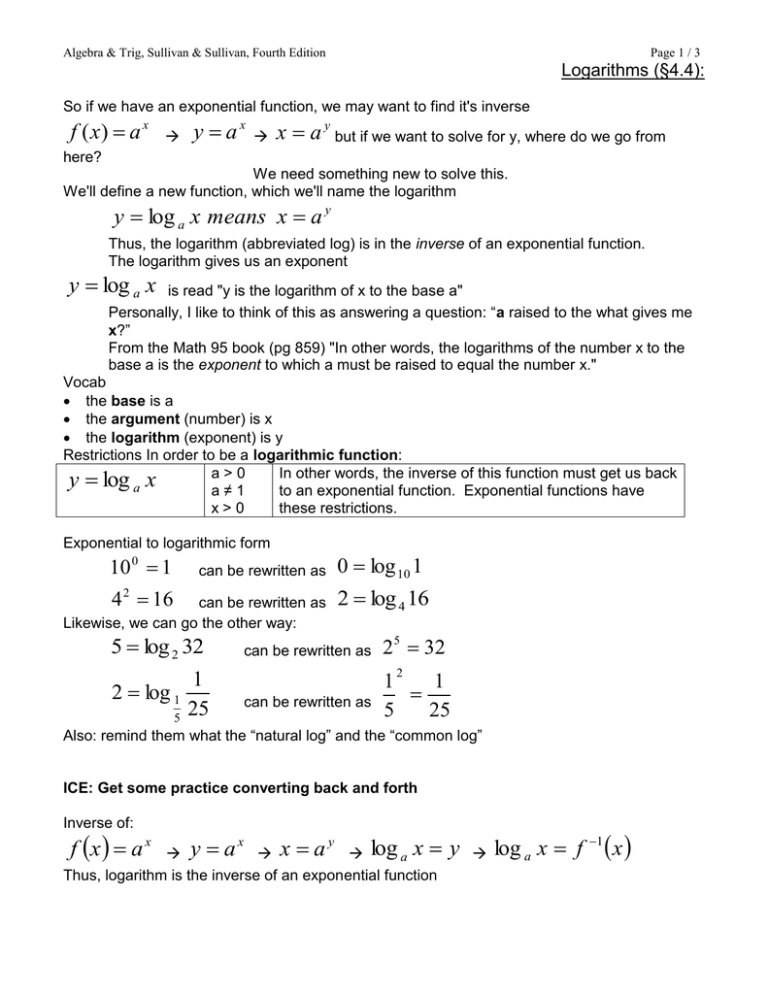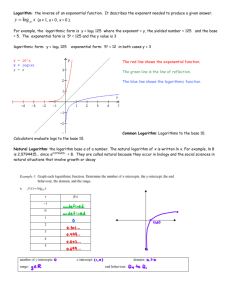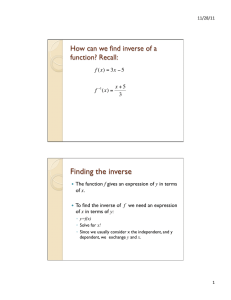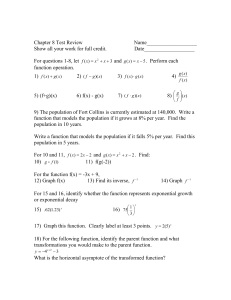Notes - Section 4.4
advertisement

Algebra & Trig, Sullivan & Sullivan, Fourth Edition Page 1 / 3 Logarithms (§4.4): So if we have an exponential function, we may want to find it's inverse f ( x) a x y ax x a y but if we want to solve for y, where do we go from here? We need something new to solve this. We'll define a new function, which we'll name the logarithm y log a x means x a y Thus, the logarithm (abbreviated log) is in the inverse of an exponential function. The logarithm gives us an exponent y log a x is read "y is the logarithm of x to the base a" Personally, I like to think of this as answering a question: “a raised to the what gives me x?” From the Math 95 book (pg 859) "In other words, the logarithms of the number x to the base a is the exponent to which a must be raised to equal the number x." Vocab the base is a the argument (number) is x the logarithm (exponent) is y Restrictions In order to be a logarithmic function: a>0 In other words, the inverse of this function must get us back y log a x a≠1 to an exponential function. Exponential functions have x>0 these restrictions. Exponential to logarithmic form 10 0 1 0 log 10 1 can be rewritten as 2 log 4 16 4 2 16 can be rewritten as Likewise, we can go the other way: 5 log 2 32 1 2 log 1 25 5 can be rewritten as 25 32 can be rewritten as 1 1 5 25 2 Also: remind them what the “natural log” and the “common log” ICE: Get some practice converting back and forth Inverse of: f x a x y a x a log a x Thus, logarithm is the inverse of an exponential function x y y log a x f 1 x Algebra & Trig, Sullivan & Sullivan, Fourth Edition Page 2 / 3 How to use this to find exact answers: Properties Useful for Solving Exponential / Logarithmic Equations (from last lecture) 1. If x y x y a a If then ax ay then x y Given the logarithm, re-write as an exponential function, then use the above rules to solve log 2 16 log 2 16 y 2 y 16 2 y 24 y 4 Domain, Range Point out (using those circle diagrams) that the domain (starting point) of a function ends up being the range (ending point) of the function’s inverse. And vice versa: the function’s range (ending point) ends up being the inverse function’s domain (starting point) , = Range of logarithmic function Range of exponential function = 0, = Domain of logarithmic function Domain of exponential function = Find the domain of: f x log 3 x 2 Since the domain has to be > 0, whatever we plug into the function must be > 0 Therefore x-2 > 0 x > 2 Graphing Logs Given f x log a x 1. Domain is x is any real number such that x > 0 Range: any real number 2. x-intercept is 1 No y intercept 3. y-axis is a vertical asymptote 4. Function is decreasing 0 < a < 1 Increasing if a > 1 1 5. Graph contains the points 1,0 , a,1 and ,1 a Algebra & Trig, Sullivan & Sullivan, Fourth Edition Page 3 / 3 Solving Logs (Make sure that they can use their calculators to find log, natural log, etc) log 3 4 x 7 2 32 4 x 7 9 4x 7 16 4x 4 x (Generally, if it’s in one form, switch it to the other, then manipulate it until you’ve got an answer)






